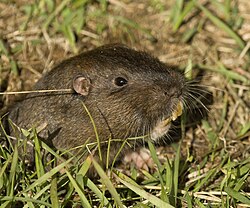| Common name | Scientific name and subspecies | Range | Size and ecology | IUCN status and estimated population |
|---|
| Botta's pocket gopher  | T. bottae
(Eydoux & Gervais, 1836)
| Southwestern United States and northern Mexico
 | Size: 8–20 cm (3–8 in) long, plus 5–10 cm (2–4 in) tail [16]
Habitat: Forest, grassland, and desert [35]
Diet: Roots, bulbs, leaves, and other vegetation [14] | LC
Unknown  [35] [35]
|
|---|
| Camas pocket gopher  | T. bulbivorus
(Richardson, 1829) | Northwestern United States
 | Size: 20–24 cm (8–9 in) long, plus 8–10 cm (3–4 in) tail [16]
Habitat: Grassland [36]
Diet: Roots, bulbs, leaves, and other vegetation [14] | LC
Unknown  [36] [36]
|
|---|
| Idaho pocket gopher
| T. idahoensis
Merriam, 1901
- T. i. confinus
- T. i. idahoensis
- T. i. pygmaeus
| Northwestern United States
 | Size: 12–15 cm (5–6 in) long, plus 4–7 cm (2–3 in) tail [16]
Habitat: Savanna, shrubland, and grassland [37]
Diet: Roots, bulbs, leaves, and other vegetation [14] | LC
Unknown  [37] [37]
|
|---|
| Mazama pocket gopher  | T. mazama
Merriam, 1897
- T. m. couchi
- T. m. glacialis
- T. m. helleri
- T. m. hesperus
- T. m. louiei
- T. m. mazama
- T. m. melanops
- T. m. nasicus
- T. m. niger
- T. m. oregonus
- T. m. premaxillaris
- T. m. pugetensis
- T. m. tacomensis (Tacoma pocket gopher)
- T. m. tumuli
- T. m. yelmensis
| Northwestern United States
 | Size: 14–17 cm (6–7 in) long, plus 5–8 cm (2–3 in) tail [16]
Habitat: Forest, savanna, shrubland, and grassland [38]
Diet: Roots, bulbs, leaves, and other vegetation [14] | LC
Unknown  [38] [38]
|
|---|
| Mountain pocket gopher  | T. monticola
Allen, 1893 | Western United States | Size: 12–16 cm (5–6 in) long, plus 5–9 cm (2–4 in) tail [16]
Habitat: Forest and grassland [39]
Diet: Roots, bulbs, leaves, and other vegetation [14] | LC
Unknown  [39] [39]
|
|---|
| Northern pocket gopher  | T. talpoides
(Richardson, 1828)
- T. t. aequalidens
- T. t. agrestis
- T. t. andersoni
- T. t. attenuatus
- T. t. bridgeri
- T. t. bullatus
- T. t. caryi
- T. t. cheyennensis
- T. t. cognatus
- T. t. columbianus
- T. t. devexus
- T. t. douglasii
- T. t. duranti
- T. t. falcifer
- T. t. fisheri
- T. t. fossor
- T. t. fuscus
- T. t. gracilis
- T. t. immunis
- T. t. incensus
- T. t. kaibabensis
- T. t. kelloggi
- T. t. levis
- T. t. limosus
- T. t. loringi
- T. t. macrotis
- T. t. medius
- T. t. meritus
- T. t. monoensis
- T. t. moorei
- T. t. nebulosus
- T. t. ocius
- T. t. oquirrhensis
- T. t. parowanensis
- T. t. pierreicolus
- T. t. pryori
- T. t. quadratus
- T. t. ravus
- T. t. relicinus
- T. t. retrorsus
- T. t. rostralis
- T. t. rufescens
- T. t. saturatus
- T. t. segregatus
- T. t. shawi
- T. t. talpoides
- T. t. taylori
- T. t. tenellus
- T. t. trivialis
- T. t. uinta
- T. t. wallowa
- T. t. wasatchensis
- T. t. whitmani
- T. t. yakimensis
| Northwestern United States and southwestern Canada
 | Size: 11–19 cm (4–7 in) long, plus 5–8 cm (2–3 in) tail [16]
Habitat: Forest and grassland [40]
Diet: Roots, bulbs, leaves, and other vegetation [14] | LC
Unknown  [40] [40]
|
|---|
| Southern pocket gopher  | T. umbrinus
(Richardson, 1829)
- T. u. arriagensis
- T. u. atrodorsalis
- T. u. atrovarius
- T. u. camargensis
- T. u. chihuahuae
- T. u. crassidens
- T. u. durangi
- T. u. emotus
- T. u. enixus
- T. u. eximius
- T. u. extimus
- T. u. goldmani
- T. u. intermedius
- T. u. juntae
- T. u. musculus
- T. u. nelsoni
- T. u. newmani
- T. u. parviceps
- T. u. potosinus
- T. u. pullus
- T. u. sonoriensis
- T. u. supernus
- T. u. umbrinus
- T. u. zacatecae
- Thomomys
| Southwestern United States and Mexico | Size: 12–18 cm (5–7 in) long, plus 5–8 cm (2–3 in) tail [16]
Habitat: Forest, shrubland, grassland, and desert [41]
Diet: Roots, bulbs, leaves, and other vegetation [14] | LC
Unknown  [41] [41]
|
|---|
| Townsend's pocket gopher  | T. townsendii
(Bachman, 1839)
- T. t. nevadensis
- T. t. townsendii
| Western United States | Size: 14–23 cm (6–9 in) long, plus 5–10 cm (2–4 in) tail [16]
Habitat: Shrubland, grassland, and inland wetlands [42]
Diet: Roots, bulbs, leaves, and other vegetation [14] | LC
Unknown  [42] [42]
|
|---|
| Wyoming pocket gopher  | T. clusius
Coues, 1875 | Western-central United States | Size: 10–13 cm (4–5 in) long, plus 5–7 cm (2–3 in) tail [16]
Habitat: Shrubland [43]
Diet: Roots, bulbs, leaves, and other vegetation [14] | LC
Unknown  [43] [43]
|
|---|




























